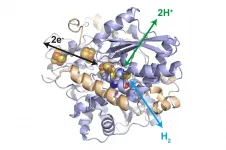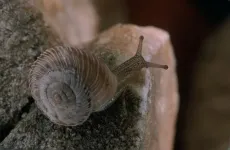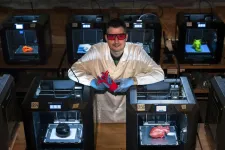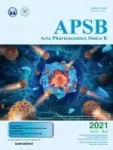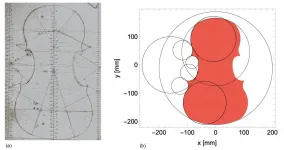Scientists design new drug compound to stop malaria in its tracks
2021-05-12
(Press-News.org) Researchers at the Francis Crick Institute and the Latvian Institute of Organic Synthesis have designed a drug-like compound which effectively blocks a critical step in the malaria parasite life cycle and are working to develop this compound into a potential first of its kind malaria treatment.
While drugs and mosquito control have reduced levels of malaria over recent decades, the parasite still kills over 400,000 people every year, infecting many more. Worryingly, it has now developed resistance to many existing antimalarial drugs, meaning new treatments that work in different ways are urgently needed.
In their research, published in PNAS, the scientists developed a set of compounds designed to stop the parasite being able to burst out of red blood cells, a process vital to its replication and life cycle. They found one compound in particular was highly effective in human cell tests.
"Malaria parasites invade red blood cells where they replicate many times, before bursting out into the bloodstream to repeat the process. It's this cycle and build-up of infected red blood cells which causes the symptoms and sometimes fatal effects of the disease," says Mike Blackman, lead author and group leader of the Malaria Biochemistry Laboratory at the Crick.
"If we can effectively trap malaria in the cell by blocking the parasite's exit route, we could stop the disease in its tracks and halt its devastating cycle of invading cells."
The compound works by blocking an enzyme called SUB1, which is critical for malaria to burst out of red blood cells. Existing antimalarials work by killing the parasite within the cell, so the researchers hope this alternative drug action will overcome the resistance the parasite has acquired.
Importantly the compound is also able to pass through the membranes of the red blood cell and of the compartment within the cell where the parasites reside.
The team is continuing to optimise the compound, making it smaller and more potent. If successful, it will need to be tested in further experiments and in animal and human trials to show it is safe and effective, before being made available to people.
Chrislaine Withers-Martinez, author and researcher in the Malaria Biochemistry Laboratory, says: "Many existing antimalarial drugs are plant derived and while they're incredibly effective, we don't know the precise mechanisms behind how they work. Our decades of research have helped us identify and understand pathways crucial to the malaria life cycle allowing us to rationally design new drug compounds based on the structure and mechanism of critical enzymes like SUB1.
"This approach, which has already been highly successful at finding new treatments for diseases including HIV and Hepatitis C, could be key to sustained and effective malaria control for many years to come."
INFORMATION:
For further information, contact: press@crick.ac.uk or +44 (0)20 3796 5252
Notes to Editors
Reference: Lidumniece, E. et al. (2021). Peptidic boronic acids are potent cell-permeable
inhibitors of the malaria parasite egress serine protease SUB1. PNAS. 10.1073/pnas.2022696118
The Francis Crick Institute is a biomedical discovery institute dedicated to understanding the fundamental biology underlying health and disease. Its work is helping to understand why disease develops and to translate discoveries into new ways to prevent, diagnose and treat illnesses such as cancer, heart disease, stroke, infections, and neurodegenerative diseases.
An independent organisation, its founding partners are the Medical Research Council (MRC), Cancer Research UK, Wellcome, UCL (University College London), Imperial College London and King's College London.
The Crick was formed in 2015, and in 2016 it moved into a brand new state-of-the-art building in central London which brings together 1500 scientists and support staff working collaboratively across disciplines, making it the biggest biomedical research facility under a single roof in Europe.
http://crick.ac.uk/
Peer reviewed
Experimental study
Cells
ELSE PRESS RELEASES FROM THIS DATE:
2021-05-12
Multiple sclerosis, or MS for short, manifests itself slightly differently in each person - which is why some call it "the disease of a thousand faces." Arguably the worst manifestation of MS is its chronic progressive form. Unlike the more common relapsing-remitting variant (RRMS), in which sufferers are often symptom-free for months or even years, patients with the primary progressive form of the disease (PPMS) see their condition steadily deteriorate with no remissions.
Poorly insulated neurons die off
Today's therapeutic approaches are based on the assumption that the immune system is making a mistake and waging an inappropriate attack on the layer of myelin that surrounds and insulates the nerve cells' long, ...
2021-05-12
AdaptiFont has recently been presented at CHI, the leading Conference on Human Factors in Computing.
Language is without doubt the most pervasive medium for exchanging knowledge between humans. However, spoken language or abstract text need to be made visible in order to be read, be it in print or on screen.
How does the way a text looks affect its readability, that is, how it is being read, processed, and understood? A team at TU Darmstadt's Centre for Cognitive Science investigated this question at the intersection of perceptual science, cognitive ...
2021-05-12
A giant mosasaur from the end of the Cretaceous period in Morocco that could have reached up to eight metres long is the third new species to be described from the region in less than a year, bringing the total number of species up to at least 13.
The high diversity of the fauna shows how mosasaurs, giant marine lizards related to snakes and Komodo dragons, thrived in the final million years of the Cretaceous period before they, and most of all species on Earth, were wiped out by the impact of a giant asteroid 66 million years ago.
The new species, named Pluridens serpentis, had long, slender jaws with over a hundred sharp, ...
2021-05-12
Modern vaccines such as those against Sars-CoV-2 use tiny lipid spheres to transport genetic information into cells and let the body build up an immune defense against the virus. A team of scientists from Erlangen, Dresden, and London has now developed a completely new method to very efficiently deliver not only genes but also drugs and other substances into cells. The researchers from the Max-Planck-Zentrum für Physik und Medizin (MPZPM) in Erlangen, the Technical University of Dresden, and The Institute of Cancer Research in London have named the method Progressive Mechanoporation and have now published it in the scientific journal "Lab on a Chip". They have also filed a patent.
Ruchi Goswami and Alena Uvizl were part of a team of scientists led by Salvatore Girardo (Erlangen) ...
2021-05-12
An enzyme could make a dream come true for the energy industry: It can efficiently produce hydrogen using electricity and can also generate electricity from hydrogen. The enzyme is protected by embedding it in a polymer. An international research team with significant participation of scientists from Technical University of Munich (TUM) has presented the system in the renowned science journal Nature Catalysis.
Fuel cells turn hydrogen into electricity, while electrolysers use electricity to split water to produce hydrogen. Both need the rare and thus expensive precious metal platinum as a catalyst. Nature has created a different solution: Enzymes, referred to as hydrogenases. ...
2021-05-12
Experts in virtual reality locomotion have developed a new resource that analyses all the different possibilities of locomotion currently available.
Moving around in a virtual reality world can be very different to walking or employing a vehicle in the real world and new approaches and techniques are continually being developed to meet the challenges of different applications.
Called Locomotion Vault, the project was developed by researchers at the Universities of Birmingham, Copenhagen, and Microsoft Research. It aims to provide a central, freely-available ...
2021-05-12
A study published in the journal Scientific Reports reveals the genetic structure of the land snail Xerocrassa montserratensis and it provides new scientific tools for the improvement of the conservation of this endemic and threatened species in Catalonia. This land mollusc, identified in the late 19th century in the Montserrat mountain, has a reduced geographical distribution limited to the province of Barcelona, and it is a protected species in the area of the natural parks of Montserrat and Sant Llorenç del Munt i l'Obac.
The study is led by the lecturer Marta Pascual, from the Faculty of Biology and the Biodiversity Research Institute of the University of Barcelona ...
2021-05-12
Skeletal muscles make a tremendous variety of actions stabilizing the body in different positions. Despite their endurance during daily activities, they can undergo several mild injuries caused by sport, accidental overstretching, or sudden overtwisting. Luckily mild injuries can be quickly healed; however, when a large part of muscles is damaged or resected surgically, the full recovery can be impossible. Muscle regeneration is challenging, but the development of innovative biocompatible materials tackles that problem. Recently, a multinational team of scientists led by dr. Marco Costantini from ...
2021-05-12
Acta Pharmaceutica Sinica B Volume 11, Issue 4 Publishes
https://www.sciencedirect.com/journal/acta-pharmaceutica-sinica-b/vol/11/issue/4
Special Issue: The Biological Fate of Drug Nanocarriers
This special issue includes seven review and nine research articles from some leading scientists in the field that further the discussion on subtopics of in vivo fate of drug nanocarriers.
Guest Editors: Wei Wu, Professor, Department of Pharmaceutics, School of Pharmacy, Fudan University, Shanghai, China; Tonglei Li, Professor, Department of Industrial & Physical Pharmacy, Purdue University, West Lafayette, IN, USA; Ying Zheng, Professor, State Key Laboratory of Quality Research in Chinese Medicine, Institute of Chinese Medical Sciences, University of Macau, Macau, China.
The Journal ...
2021-05-12
How to predict the sound produced by a tonewood block once carved into the shape of a violin plate? What is the best shape for the best sound? Artificial Intelligence offer answers to these questions.
These are the conclusions that researchers of the Musical Acoustics Lab of Politecnico di Milano presented in a study that was recently published in Scientific Reports.
In the article "A Data-Driven Approach to Violinmaking" the Chilean physicist and luthier Sebastian Gonzalez (post-doc researcher) and the professional mandolin player Davide Salvi (PhD student) show how a simple and effective neural network is able to predict the vibrational be-havior of violin plates. This prediction is obtained from a limited set of geometric and mechanical ...
LAST 30 PRESS RELEASES:
[Press-News.org] Scientists design new drug compound to stop malaria in its tracks

